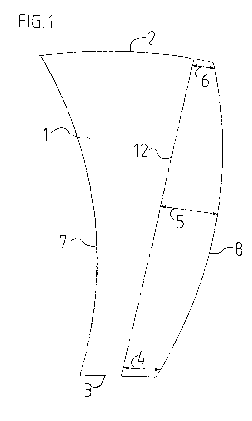Some of the information on this Web page has been provided by external sources. The Government of Canada is not responsible for the accuracy, reliability or currency of the information supplied by external sources. Users wishing to rely upon this information should consult directly with the source of the information. Content provided by external sources is not subject to official languages, privacy and accessibility requirements.
Any discrepancies in the text and image of the Claims and Abstract are due to differing posting times. Text of the Claims and Abstract are posted:
| (12) Patent Application: | (11) CA 2889924 |
|---|---|
| (54) English Title: | ROTOR BLADE FOR A WIND TURBINE |
| (54) French Title: | PALE DE ROTOR POUR EOLIENNE |
| Status: | Deemed Abandoned and Beyond the Period of Reinstatement - Pending Response to Notice of Disregarded Communication |
| (51) International Patent Classification (IPC): |
|
|---|---|
| (72) Inventors : |
|
| (73) Owners : |
|
| (71) Applicants : |
|
| (74) Agent: | NORTON ROSE FULBRIGHT CANADA LLP/S.E.N.C.R.L., S.R.L. |
| (74) Associate agent: | |
| (45) Issued: | |
| (86) PCT Filing Date: | 2013-10-29 |
| (87) Open to Public Inspection: | 2014-05-08 |
| Availability of licence: | N/A |
| Dedicated to the Public: | N/A |
| (25) Language of filing: | English |
| Patent Cooperation Treaty (PCT): | Yes |
|---|---|
| (86) PCT Filing Number: | PCT/CH2013/000188 |
| (87) International Publication Number: | WO 2014067020 |
| (85) National Entry: | 2015-04-29 |
| (30) Application Priority Data: | ||||||
|---|---|---|---|---|---|---|
|
The present invention relates to a rotor blade (1) and a corresponding rotor for a wind turbine having a reduced rotor diameter and improved performance. The rotor blade (1) for a wind turbine has a blade root (3) with a defined first diameter as an attachment to a hub, and a rotor blade end (2), with a second defined diameter, opposite the blade root. The rotor blade (1) also has a trailing edge (7) and a leading edge (8) in relation to the direction of rotation of the rotor blade (1) during operation. The leading edge (8) and the trailing edge (7) each have a curvature. The first diameter is smaller than the second diameter.
L'invention concerne une pale de rotor (1) et un rotor correspondant d'une éolienne présentant un diamètre de rotor réduit pour une performance accrue. Cette pale de rotor (1) destinée à une éolienne comporte une emplanture (3) présentant un premier diamètre défini, comme élément de liaison à un moyeu, et une extrémité (2) de pale de rotor opposée à l'emplanture et présentant un second diamètre défini. Elle présente en outre un bord de fuite (7) et un bord d'attaque (8) par rapport à la direction de rotation de la pale de rotor (1) lorsque celle-ci est en fonctionnement. Le bord d'attaque (8) et le bord de fuite (7) présentent chacun une courbure. Le premier diamètre est inférieur au second diamètre.
Note: Claims are shown in the official language in which they were submitted.
Note: Descriptions are shown in the official language in which they were submitted.

2024-08-01:As part of the Next Generation Patents (NGP) transition, the Canadian Patents Database (CPD) now contains a more detailed Event History, which replicates the Event Log of our new back-office solution.
Please note that "Inactive:" events refers to events no longer in use in our new back-office solution.
For a clearer understanding of the status of the application/patent presented on this page, the site Disclaimer , as well as the definitions for Patent , Event History , Maintenance Fee and Payment History should be consulted.
| Description | Date |
|---|---|
| Common Representative Appointed | 2019-10-30 |
| Common Representative Appointed | 2019-10-30 |
| Application Not Reinstated by Deadline | 2019-10-29 |
| Time Limit for Reversal Expired | 2019-10-29 |
| Deemed Abandoned - Failure to Respond to Maintenance Fee Notice | 2018-10-29 |
| Inactive: Abandon-RFE+Late fee unpaid-Correspondence sent | 2018-10-29 |
| Inactive: Cover page published | 2015-05-26 |
| Inactive: Notice - National entry - No RFE | 2015-05-07 |
| Inactive: IPC assigned | 2015-05-07 |
| Inactive: First IPC assigned | 2015-05-07 |
| Application Received - PCT | 2015-05-07 |
| National Entry Requirements Determined Compliant | 2015-04-29 |
| Application Published (Open to Public Inspection) | 2014-05-08 |
| Abandonment Date | Reason | Reinstatement Date |
|---|---|---|
| 2018-10-29 |
The last payment was received on 2017-10-30
Note : If the full payment has not been received on or before the date indicated, a further fee may be required which may be one of the following
Please refer to the CIPO Patent Fees web page to see all current fee amounts.
| Fee Type | Anniversary Year | Due Date | Paid Date |
|---|---|---|---|
| Basic national fee - standard | 2015-04-29 | ||
| MF (application, 2nd anniv.) - standard | 02 | 2015-10-29 | 2015-04-29 |
| MF (application, 3rd anniv.) - standard | 03 | 2016-10-31 | 2016-10-24 |
| MF (application, 4th anniv.) - standard | 04 | 2017-10-30 | 2017-10-30 |
Note: Records showing the ownership history in alphabetical order.
| Current Owners on Record |
|---|
| WEPFER TECHNICS AG |
| Past Owners on Record |
|---|
| HANS WEPFER |